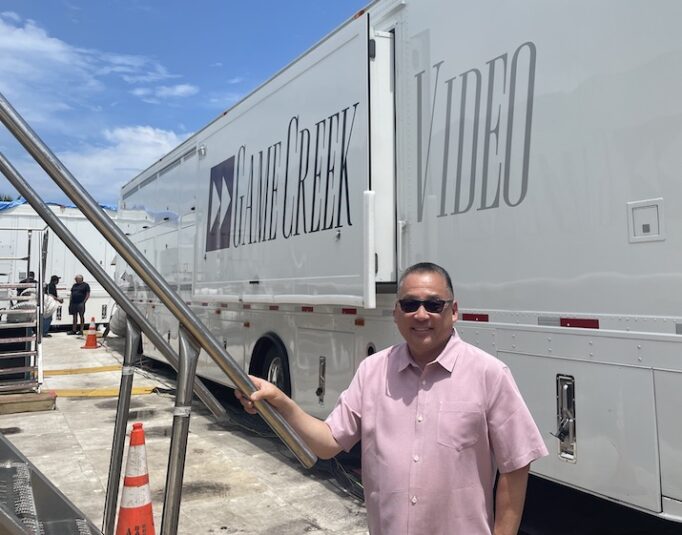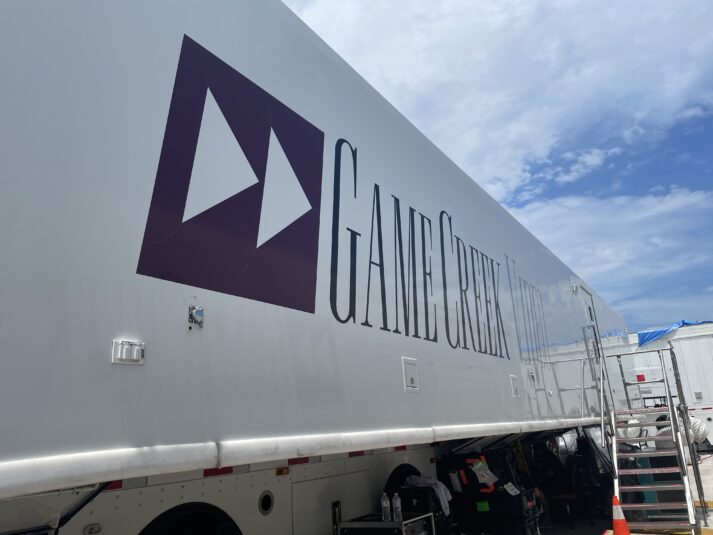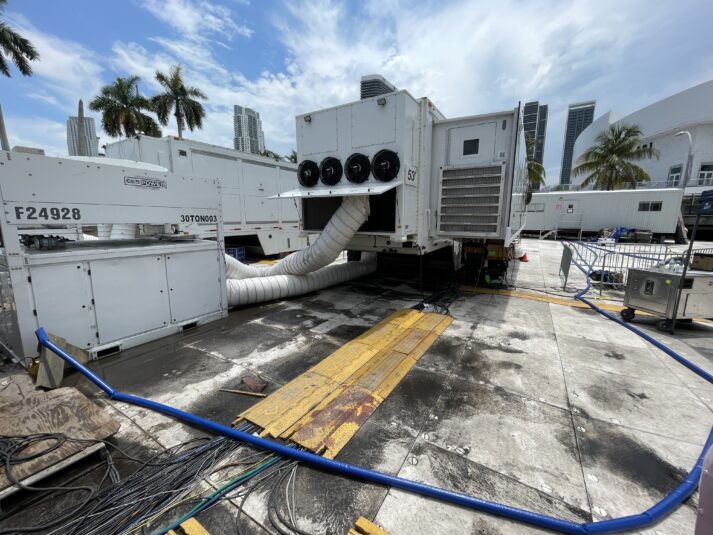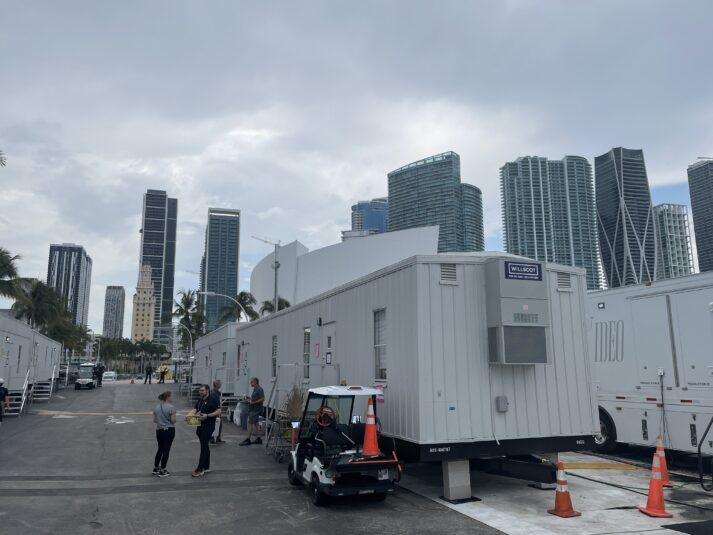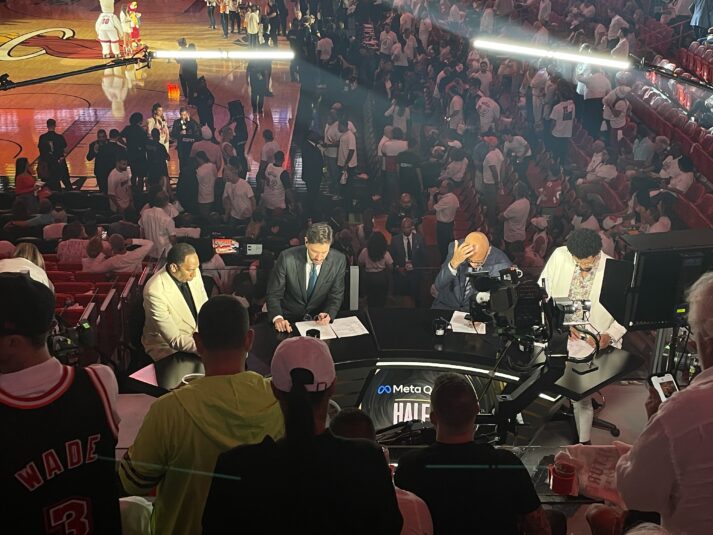Live From NBA Finals: ESPN Operations Weathers South Florida Storms, Cross-Country Travel for Heat-Nuggets Title Bout
Covering games 2,000 miles apart requires both a strategy and flexibility
Story Highlights
The Denver Nuggets played the role of spoiler and ruined the party for Miami Heat fans at Kaseya Center in Game 3 of the NBA Finals. With one more game to go in Southern Florida before shifting back to the Mile High City, ESPN’s operations team has withstood the challenges of this nation-spanning championship with logistical know-how and arduous planning.
“[The Finals] have gone very smoothly, but a lot of our job is about reducing risk,” says Eddie Okuno, senior remote operations specialist, ESPN. “We always have to keep an eye on the calendar and the standings to see which cities we’ll be going to.”
Game of Logistical Chess: Team Maps Out Potential Sites Prior to Finals
From an operational perspective, one of the hardest parts about the job is foreseeing where the action will end up. At the beginning of the NBA Playoffs, many teams and their home cities were in the mix to host the NBA Finals, and the crew adjusted its plans as the postseason went along. By the Conference Finals, the potential sites had been reduced to four: Crypto.com Arena in Los Angeles and Ball Arena for the Western representative, TD Garden in Boston and Kaseya Center in Miami for its Eastern counterpart. At that stage, Okuno deployed a strategy to alleviate some of the stress that comes with the unknown.
“Our strategy is to build City 1 and City 2 infrastructures that are identical between our two mobile-unit providers, NEP Group and Game Creek Video,” he says. “We stayed with our regular ABC Saturday Primetime strategy for the first two rounds, but, when we got to the Conference Finals, we just didn’t have time to set up everything for a big show in one day.”
Luckily, the team on the NEP trucks knew fairly quickly that they’d be going to Denver when the Nuggets made relatively quick work of the Los Angeles Lakers. If the Lakers had made a dramatic comeback and the Heat finished off the Boston Celtics, the scenario would have changed, with the West Coast crew having to scramble to Los Angeles since the Lakers would have been the higher seed. When the Heat-Celtics series became a lot more interesting with a winner-take-all Game 7, the East Coast-based team knew that they’d be traveling regardless of the winner. As Boston gained momentum from a 3-0 hole, Okuno and company had to consider both cities as a possibility.
“When we got to Game 6,” he says, “we had to start building out for Boston because the series would have ended on Monday, May 29 and we would have to be ready to go there for Game 1 on Thursday, June 1. Ultimately, Boston lost, and we headed out to Denver.”
Sifting through cities and laying out scheduled departures requires moving a lot of parts, and each city has a unique venue. For example, the Milwaukee Bucks play in the four-year-old Fiserv Forum with an updated and broadcast-ready infrastructure. On the other hand, all the teams in the Conference Finals play in venues that opened before 2000.
“We needed to know how much land or space would be given to us for our compound [at each venue] and when it would be available to us,” Okuno explains. “Between the NBA and the venues, there were multiple things that we had to coordinate.”
Quick Thinking: Miami Thunderstorms Flood the Compound
Playing ball in the Sunshine State comes with a hefty number of unexpected thunderstorms. Typically going as quickly as they come, these pockets of rain can still pack an aggressive punch. When you place these torrential downpours over a broadcast compound with equipment that isn’t compatible with water, producing games in Miami can be physically and figuratively slippery. Arriving at Kaseya Center May 30, the operations crew had a few days to construct a compound on a grass field before the surrounding area became too muddy. Although rain is always expected, it’s difficult to know when these storms hit, how much of a deluge they will bring, and how long they’ll stick around.
“When we first came here,” says Okuno, “the entire compound was flooded, and we were pretty much underwater by about almost 2 ft. We had to install pumping stations at the center of our compound and move the trucks out of that area.”
Among other efforts to combat the problem, the temporary floor of the compound was built on a slant to enhance runoff and drainage.
“[Unforeseen events] like that unfortunately happen,” he notes. “Fighting Mother Nature at this time of the year is always part of the challenge.”
Production Standouts: Broadcast Includes Sony HDC-4800 Cinematic 4K Cameras
Inside the venue, the team has a total of 55 camera feeds to choose from for the 1080p broadcast. Leading the way, the Sony HDC-4800 cinematic 4K camera is providing super-slow-motion shots at 8X speed. Sony has a large presence in the productions, with more than 30 cameras deployed in the lower bowl and around the arena, including 18 HDC-4300’s (five handhelds at speeds from 4X to 6X), two P-43’s above-the-rim robos, two HDC-5500’s, and two PXW-Z450’s. More important, the camera manufacturer plays a part in the Skycam system with a Sony HDC-P50 and in ESPN’s preferred shallow–depth-of-field rig with a Sony Alpha 1.
In the compound, the efforts of the 85 credentialed personnel is centered on two sets of mobile units in each city. In Denver’s Ball Arena, NEP EN1 A, B, and C is handling the game and NCP2 studio coverage. Onsite at Miami’s Kaseya Center are Game Creek Video 79 A and B units and Victory B for the game and Gotham for studio coverage.
Each broadcast is produced via multiple remote workflows. Through ESPN’s REMCO (remote-controlled) model, the onsite team integrates graphics and scorebug from operators at headquarters in Bristol, CT. Four EVS operators also are working out of the Bristol facility.
As for lenses, all cameras are using Canon lenses in both Denver and Miami. For example, the Skycam is using a CJ20x5 lens, and others are leveraging the DIGISUPER 122x, the DIGISUPER 95x, the DIGISUPER 27x, CJ15ex4.3, and CJ20ex5 lenses.
Additional Activity: Various Mixed-Reality Opens, Onsite Studio Show
Besides the game production, the operations crew is pitching in on other activations at the NBA Finals. One of the most notable is seen at the beginning of the live telecast. Produced by ESPN Creative Services, a special mixed-reality (MR) open joins the graphics package that debuted at the start of the NBA regular season. The crew, led by Creative Director Lucas Nickerson, developed a new presentation for each game. The opens wouldn’t be possible without the technological foundation established by the operations team.
“We began testing these during the Conference Finals,” says Okuno. “Since it’s very time-sensitive with how we reveal it on Skycam, we wanted it done properly in terms of positioning and placement. We made a few adjustments for the Finals, and it has been working out extremely well.”
In addition, technology is devoted to the onsite studio sets at each building. Anchored by five total cameras, two of the five are handheld and are shared with the game production.
Close-Knit Group: ESPN Ops Leans on Experience, Trusted Broadcast Partners
To produce a massive endeavor like the NBA Finals, a network needs the production and operations crews to work closely together. The creative vision from Lead Producer Tim Corrigan and Lead Director Mike Schwab is enhanced by impressive technology and a reliable working environment. Okuno and his team — Senior Technical Director Ross Flagg, Senior Audio Operator Scott Pray, Senior Audio Integration Devin Barnhart, Senior Comms Integration Patrick Martin, Senior Video Integration Mark Morel, Senior EVS Operator Nathan Beck, and Senior Media Specialist Scott Meglemre —work in sync not only internally but also with the production crew.
“We’ve all done this job for a long time,” Okuno notes. “Our team is the best in the business. On the technical side, we keep things simple to make sure that everybody understands what we’re trying to do.”
Another advantage of strong relationships year after year is knowing the valuable work done by vendors and manufacturers. Whether it’s working within technologically advanced mobile units from NEP Group and Game Creek Video, receiving the necessary energy resources from CES Power, the clean and durable flooring provided by Sunbelt Rentals, and more, external partners make a huge difference.
“They’re just as important to us as anybody on our team,” says Okuno. “Everybody is invested in making sure that we have the best show possible.”
Coverage of Game 4 of the 2023 NBA Finals will begin at 8:30 p.m. ET on Friday, June 9 on ABC.
